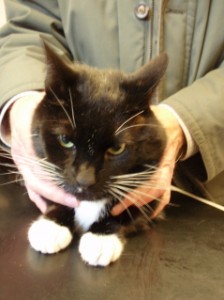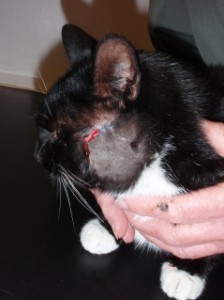Cat bite abcesses
Cat bite abscesses are a very common problem seen in the vets. Typically the cats are quiet and lethargic and may not be eating. They ccan be lame if they have been bitten on a leg, and may have a swelling where they are bitten, there is commonly pus in the wounds. They are easily treated with anti-biotics.
What are cat bite abscesses?
- Cat Bite Abscesses (CBA) are a very common problem among cats, especially those who live in urban areas where lots of cats live in close proximity
- They occur after cats have been fighting and have bitten each other.
- Cat mouths contain a lot of bacteria, which cause them no harm, but when they bite each other, and these bacteria gain entrance to under the skin, nasty infections and abscesses can occur.
- If you are bitten or badly scratched by a cat, you should immediately seek medical advice and treatment.
Clinical signs of cat bite abscesses
The symptoms of cat bite abscesses include:
- Bleeding – the abscesses themselves take several days to form as the pus builds up, but you may spot blood from the initial wound. A cat bite wound is often easily identified, as there will often be 2 small holes separated by about an inch gap, where the cats canine teeth ( fangs) entered the skin.
- Lethargy and anorexia – cat bites cause nasty infections, and these make the cats temperature very high, they can also be painful. These two things together act to make you cat feel very poorly, they are often quiet, withdrawn and refuse food
- Painful swellings – as the pus builds up under this skin, it will cause a painful swelling, and you cat may react very aggressively if you handle them or touch the swelling. These swellings can occur anywhere on the body but are most common on the head ( if they have stood their ground) or on the tail base or haunches ( if they were running away!)
- Pus – Cat bite abscesses will normally contain large amounts of foul smelling pus, which will drain out once it has burst. They will most often drain out of the original bite wounds.

This cat has a cat bite abscess on this face. The left side of the face is clearly swollen when compared to the right.

This is the same cat after the hair was clipped from the area. Pus and blood can be seen coming from the bite wound.
Treatment of cat bite abscesses
- Drainage – the most important treatment for a cat bite abscess is to drain all the pus out. With the pus will come the majority of the infection, and make it much easier to heal. Some abscesses will burst and drain themselves, others will require lancing.
- Flushing – sometimes your vet may flush the wound out with sterile water. This removes all the pus and as much of the bacterial infection as possible.
- Antibiotics – these are almost always required with cat bite abscesses. Generally courses last about a week and involve daily tablets. There is now an antibiotic injection available which lasts for 10 days, and can be very useful in cats which are difficult to tablet.
On-Going Care
- Generally once they have been treated, cat bite abscesses clear up very well.
- If your cat gets recurring abscesses, ensure your cat is neutered, and if there are any stray cats around, and they are not neutered and are causing a problem, try contacting the RSPCA, the CPL (Cats Protection League) or your local vets for help.
- Sometimes, cats with recurring abscesses have problems with their immune systems. These cats should be blood tested and investigated for these.
Please note, this is an advice only website, if you can any specific concerns or queries about your pet, you should speak to your vet.